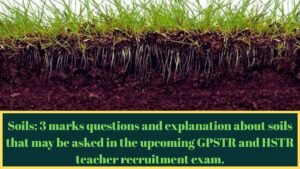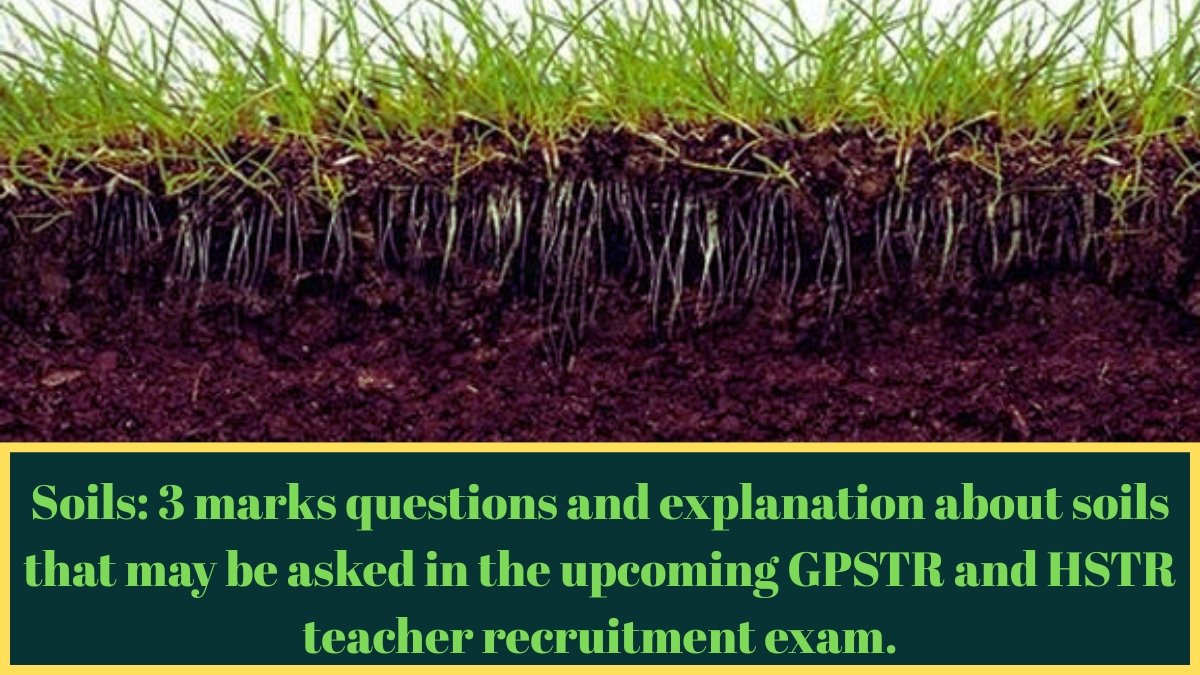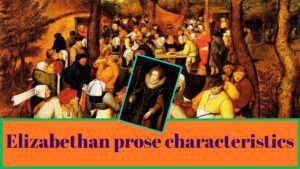Soils: 3 marks questions and explanation about soils that may be asked in the upcoming GPSTR and HSTR teacher recruitment exam.

1. The crop mainly grown in hills is:
1) sweet corn
2) sweet jowar
3) sweet potato
4) sweet pea
Ans:- 3) sweet potato
• Sweet potato can be grown on hills or plains.
• It is called Sakkar Kand in Nepal.
• It is grown in the Terai and central hills across the country.
———————————————————————
2. Humus is a type of
1) fossil seen on the rocks
2) decaying organic matters in soil
3) fertilizers applied in soil
4) special growth found in plants
Ans:- 2) decaying organic matters in soil
• Decomposition refers to decayed and partially decayed organic matter or animal and plant matter in the soil.
• The top layer of soil is usually dark in color due to the abundance of humus and minerals.
• Humus makes the soil fertile and provides nutrients for plant growth.
————————————————————————-
3. The significant quantity of upper soil is formed by
1) Igneous rock
2) Sedimentary rock
3) Metamorphic rock
4) Biological degradation
Ans:- 2) Sedimentary rock
• Sedimentary Rocks:- The rocks in the outer layer of the earth are weathered by the elements of the atmosphere. They are also broken into pieces by the agents of weathering such as flowing water, snow, wind, groundwater waves, etc., and are carried and deposited in layers one above the other in the shallow oceans or lakes. Gradually, these pieces are bound together by iron oxide and calcium and become rocks.
————————————————————————-
4. In a desert region, soil erosion can be checked by
1) Tree plantation/afforestation
2) Crop rotation
3) Contour ploughing
4) Using farm manure
Ans:- 1) Tree plantation/afforestation
• Soil erosion in desert areas can be checked through tree planting and afforestation.
————————————————————————
5. The land which is not cultivated every year though it is suitable for cultivation:
1) Waste land
2) Pasture land
3) Fallow land
4) Cultivable waste land.
Ans:- 4) Cultivable waste land.
• Current fallow land:- Cultural practices adopted to give the land a rest
• The practice is called fallowing. The land regains lost fertility through natural processes. Under current fallowing, land is left uncultivated for one or less than one agricultural year.
• Fallow land other than currently fallow:- Cultivable land
• When land is left uncultivated for more than one year but less than five years, it is classified as fallow except for current fallow/fall.
• Cultivable barren/barren land:- If land is left uncultivated for more than five years, it is classified as cultivable fallow land.
————————————————————————–
6. Which one the following solls is used for the production of bricks?
1) Peaty and organic
2) Saline
3) Laterite
4) Red and yellow
Ans:- 4) Red and yellow
• Red soil: This soil is formed due to the weathering of granite rocks.
• It is red in color and contains a lot of iron. Generally, the surface layer of this soil is red, but if you go deeper, it is yellow. Red soil is the second highest in the country in terms of area. It covers 18.49% of the land area.
• In a microscopic perspective:- Red soil is formed as a result of natural weathering of old crystalline rocks, low in clay and sand.
• Red clay soil is used for the production of bricks.
• The state of Tamil Nadu has the highest red soil distribution in the country.
————————————————————————–
7. Plantation of trees on a large scale to check soil erosion are called:
1) Shelter belts
2) Contour ploughing
3) Strip cropping
4) Afforestation
Ans:- 4) Afforestation
• The cultivation of trees in areas without forests is called afforestation.
• Because plant roots hold the soil, afforestation prevents soil erosion and allows it to better retain water.
————————————————————————
Soils: 3 marks questions and explanation about soils that may be asked in the upcoming GPSTR and HSTR teacher recruitment exam.

8. Soil formed by leaching and oxidation is
1) Black soil
2) Laterite soil
3) Red soil
4) Montane soil
Ans:- 2) Laterite soil
• Laterite Soils:- These soils receive high rainfall i.e. annually.
• In areas with rainfall of more than 200 cm. They are formed by the washing of soil minerals. In these soils, the lime and silica, which are easily soluble in water, are completely washed away and transported to the deeper layers of the soil. Due to this, the topsoil is composed of iron and aluminum compounds. This soil is red in color due to iron oxides.
• The hot and humid tropical regions of India are covered with clayey soils, which are formed by the weathering and disintegration of rocks found in hills and mountain ranges.
• It is mainly found in the Western Ghats, some parts of the Eastern Ghats and the northeastern hills (3.70%).
• Horticultural crops such as tea, coffee, rubber, cashew, and areca nuts are grown in this soil.
————————————————————————
9. Soil factors are otherwise known. as:
1) Edaphic factors
2) Biotic factors
3) Physiographic factors
4) Climatic factors
Ans:- 1) Edaphic factors
• Edaphology is concerned with the influence of soil on living organisms, especially plants. It is one of the two main branches of soil science. The other is pedology, which deals with how soil affects plant growth and human use of land. Edaphology is the study of the overall use of land by humans.
————————————————————————–
10. Highly specialized form of agriculture in which crops like coffee, tea and rubber are cultivated refer to
1) multiple cropping
2) plantation agriculture
3) terrace farming
4) extensive farming.
Ans:- 2) plantation agriculture
• The total area under cultivation of tea, coffee, rubber and cocoa, the most important of which are the horticultural crops produced in India, is only 1.46 million hectares. This is 0.6% of the total cultivated area of the country, which is very small compared to the total cultivated area, but the importance of their production is very great.
———————————————————————–
11. Identify the most infertile amongst the following soils.
1) Black cotton soil
2) Alluvial soil
3) Laterite soil
4) Peaty soil
Ans:- 3) Laterite soil
• Maize soil:
• This soil is formed by the deposition of rivers and is mainly found in floodplains and estuaries. It is highly fertile and is found in low-lying floodplains.
• Black soil:- This soil retains water for a long time and becomes very hard during dry periods. Thus, it is useful for growing important crops.
• Peat, also known as turf, is a collection of partially decomposed vegetation or organic matter. The quality of these soils is often poor compared to their fertility.
————————————————————————-
12. Which one of the following pairs is not correctly matched ?
1) Khadar – Zonal soil
2) Podzol-Zonal soil
3) Chestnut-Zonal soil
4) Bhangar-Azonal soil
Ans:- 1) Khadar – Zonal soil
• Alluvial soils (khadar and bhangar) are non-zonal soils.
• Zonal soils:- These types of soils are called zonal soils because they are distributed in zones along the latitudes according to the climate of the respective region.
• Interzonal soils:- These types of soils are formed under local specific conditions in any climatic zone. Their formation is incomplete. The main ones are: vegetated soils, silty soils, saline soils,
• Azonal soils:- These are soils that have been transported and deposited by weathering agents rather than by the influence of weathering. The main types of soils in this type are: mountain soils, alluvial soils, coastal soils, glacial soils, wind-formed soils, and volcanic soils.
—————————————————————————
13. ‘Terra rossa’ is a Latin word which means
1) hot area
2) red terrain
3) lateritic region
4) region near the poles
Ans:- 2) red terrain
• Terra Rossa is another name for “red soil” or “red land” in Latin or Italian.
• It is a type of red clay produced by the weathering of limestone.
• Terra Rossa is commonly found in areas with a Mediterranean climate.
—————————————————————————
14. The soils which are rich in Calcium are known as
1) Pedocals
2) Pedalfers
3) Podsols
4) Laterites
Ans:- 1) Pedocals
• Pedocal :- Pedocal is found in dry, temperate regions where grasslands and brush are the main forms of vegetation.
• It is unique due to the cat layer formed from calcium carbonate.
• Pedalter is found in moist forest areas, especially in many areas of the temperate, eastern United States.
• The dark brown and black color comes from aluminum clay and iron oxide. It is a very fertile soil.
• Laterite soils are found in tropical regions. They are nutrient poor due to chemical weathering. They contain practically no humus.
——————————————————————————
15. Who of the following has given the term rhizoshere:
1) Garret
2) Alexopolous
3) Hiltner
4) None of the given options
Ans:-3) Hiltner
• Lawrence Hilber is credited with being the first scientist to coin the term “rhizosphere” in 1904. The term is derived from the Greek word ‘rhiza’, meaning ‘root’ and ‘sphere’, meaning ‘sphere of influence’.
• Hilper defines the rhizosphere as the zone of soil adjacent to the roots of legumes, which contains a high level of bacterial activity.
—————————————————————————-
16. The asha-grey soils of high-latitude coniferous forests are known as:
1) Tundra soils
2) Podsols
3) Grey-Brown soils
4) Red and Yellow soils
Ans:- 2) Podsols
• Podols:- These are ashy-gray soils that occur in the high-latitude coniferous forest zone with very long cold winters, short cool summers, and moderate rainfall throughout the year. These soils are acidic. They are useful for dairy farming and mixed farming.
• Tundra Soils:- Low temperatures throughout the year, compacted subsoil, low evaporation, short growing season, and slow decomposition of plant debris have all influenced soil formation.
• Grey brown Soil:- This has the characteristics of Podol soil.
• However, due to being heavily washed, calcium & magnesium are found in it. This soil is also acidic.
—————————————————————————






I will attend this exam
I will sure that I will attend this exam it nice topic
All the best sir
It so nice topic
Thank you